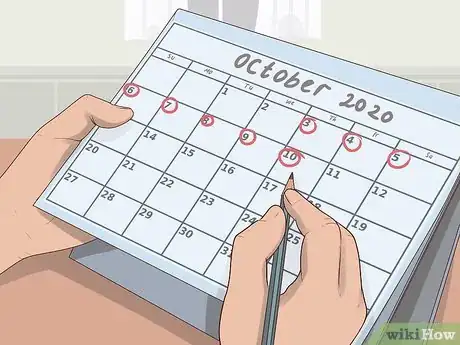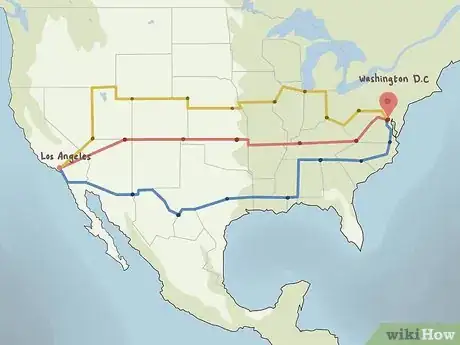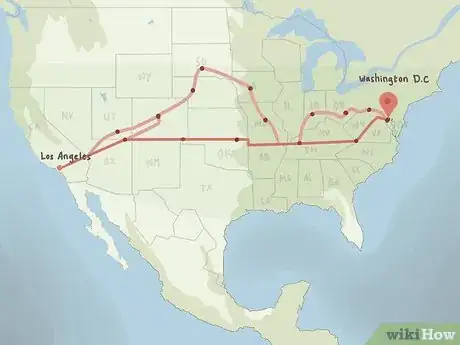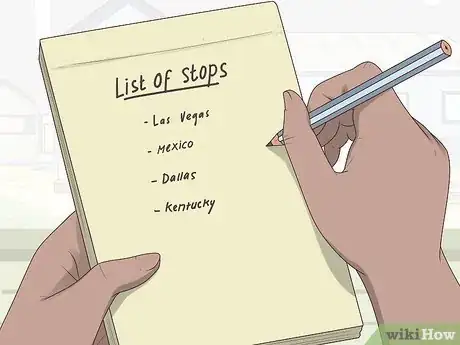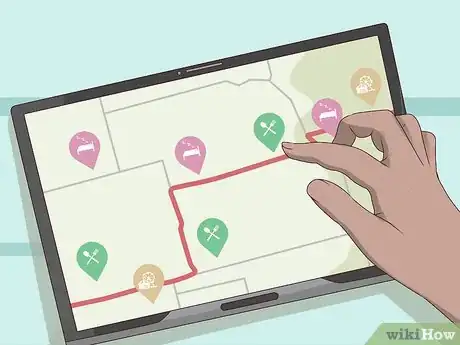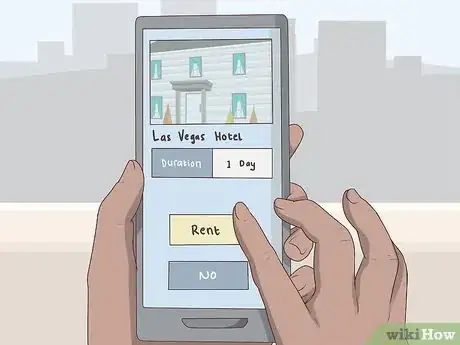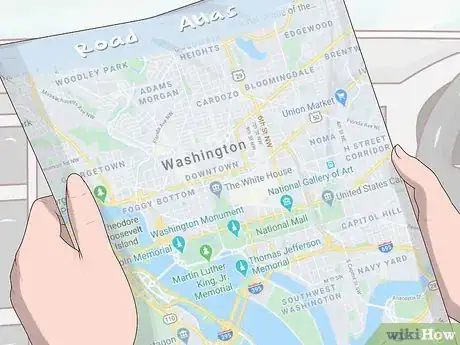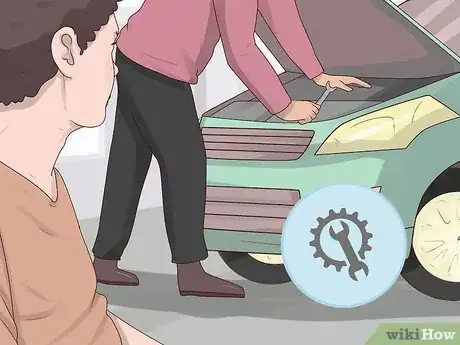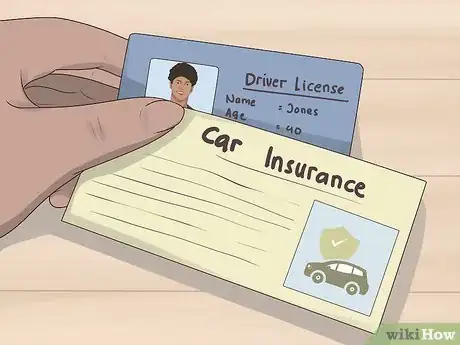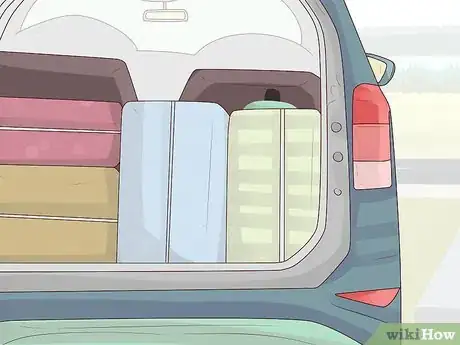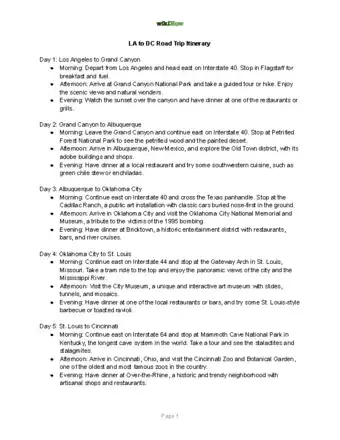This article was co-authored by wikiHow Staff. Our trained team of editors and researchers validate articles for accuracy and comprehensiveness. wikiHow's Content Management Team carefully monitors the work from our editorial staff to ensure that each article is backed by trusted research and meets our high quality standards.
There are 7 references cited in this article, which can be found at the bottom of the page.
This article has been viewed 44,269 times.
Learn more...
A cross-country road trip is the ultimate American adventure. Driving from Los Angeles to Washington, DC will give you a unique opportunity to explore the country with plenty of exciting stops along the way. Depending on the route you take, you’ll be driving at least 2,600 or 2,700 miles, which adds up to about 40 hours on the road. Researching stops along the way, crafting your itinerary, and getting your vehicle ready will take some effort ahead of time. But with the right attitude and an explorer's spirit, you'll be able to enjoy yourself out on the open road.
Steps
Determining Your Route
-
1Decide how many days you’ll spend on your road trip. Your free time might be determined by a school holiday or a limited number of days off of work, or you might have more flexibility to choose a trip duration. Either way, count up the number of days you have available for your trip. Block out 4 days for your trip if you’re aiming for 10-hour driving days, not including stops. Add at least 2 to 4 more days if you’d like to go at a slower pace or make stops along the way.[1]
- If you’re planning a roundtrip adventure, you’ll need a bare minimum of 8 days overall. Divide your trip length in half when planning the LA to DC portion.
-
2Calculate how many hours you’ll need to spend driving each day. If you head directly from LA to DC along the interstate, you’ll spend about 40 hours driving.[2] Divide 40 hours of driving by the number of days you have available. Then shift the hours around if you’d like to have a few heavy driving days, a few lighter driving days, and/or days where you stay in one spot.
- Say you have 10 days available to get from LA to DC. You could plan to drive 4 hours every single day or 8 hours every other day.
- If you’re planning a 6-day road trip, you’ll need to be on the road for about 6 or 7 hours each day, on average.
- Keep in mind that stops and diversions will result in more driving hours.
Advertisement -
3Look on a map to compare the different interstate routes. There are a few ways to get across the US from LA to DC via interstate highways. Take a look at the available routes through a physical or online map. Scan along each route to see which cities, states, and regions each interstate passes through.
- Major cities along I-40 E include Flagstaff, AZ; Albuquerque, NM, Amarillo, TX; Oklahoma City, OK; Ozark, AK; Memphis and Nashville, TN; and Roanoke, VA.[3]
- Along I-15 N you’d pass through Las Vegas, NV; the middle of Utah; Denver, CO; the center of Kansas; Kansas City and St. Louis, MO; Indianapolis, IN; Columbus, OH; the bottom corner of Pennsylvania; and the western part of Maryland.
- If you took I-10 E and I-20 E, you could visit Phoenix and Tucson, AZ; El Paso, Fort Worth, and Dallas, TX; Memphis and Nashville, TN; and Roanoke, VA.
-
4Select 1 or more interstate highways to follow along your route. If there’s a specific city you want to stop in, pick the route that leads you there. Feel free to switch up your route to reach other areas of interest. Just be sure you to work enough time for a detour into your schedule.
- If you plan to go directly from LA to DC, you could choose to stick to I-40 E all the way, or you could start with I-40 E and switch to either I-70 E or I-64 E.[4]
- To stay north of that route, use I-15 N as your primary interstate.
- To swing through the southern states, take I-10 E and I-20 E.
Preparing an Itinerary
-
1Make a list of all the specific stops you’re planning to make. Once you’ve chosen a general route to follow, narrow your focus to the points of interest along that route. Select a few destinations to work into your trip. Aim for cities and sights that are evenly spaced out if you’d like an even balance between driving and sightseeing.
- If you want to visit cities that are closer together, plan for a few shorter driving days. On the other hand, if you’re aiming to visit cities that are far apart, account for a couple of longer driving days to get to each destination.
- For example, if you definitely want to stop in Las Vegas and Denver, you’ll need to drive about 5 hours during the first day to get to Vegas. It will take another 11 to 12 hours to get to Denver, so you could consider finding a halfway point to spend the night.[5]
-
2Research attractions, restaurants, and rest stations along your route. Check out a travel guidebook or travel website for details about what there is to see and do in each area, and ask people you know for recommendations. [6] Pick out restaurants in advance, too, so you don’t waste your time searching around when you have limited time to explore. Then scan your driving route to find out where rest stops are located, so you don’t end up driving for hours without being able to get gas or use the restroom.
- Armed with all of this information, make a list of the national parks, museums, historic sites, and other attractions that you’ll be visiting during your road trip.
- Take a little detour towards the start of your trip and explore the Grand Canyon or the Painted Desert in Arizona.
- In Albuquerque you could plan a leisurely stroll around the Old Town area.
- In Nashville, maybe you’d want to tour the Country Music Hall of Fame or book concert tickets.[7]
- If you pass through Virginia, consider checking out the Blue Ridge Mountains within the Shenandoah National Park.
- Give yourself some time to see the White House and some of the museums once you get to DC.
-
3Book all of your hotels or campgrounds in advance. Plan your nights according to the needs of your group. If you are traveling as a family on a vacation with older relatives, hotels will probably be your best bet. If you are a group of college boys traveling during semester break, campgrounds may be a better option. Refer to guidebooks or travel sites to find lists of hotels or campgrounds located at each stopping point along your route. Look for nice accommodations that fit within your budget. Reserve a room or campsite before you hit the road. This way, you’ll know you’ll have a comfortable, affordable place to spend the night. Once you’re out on the road, use your hotel bookings to help you stick to your daily driving goals and itinerary.[8]
- The last thing you want after a long day on the road is to pull up to a hotel only to find it’s fully booked or flea-ridden.
- If you have a reservation set up, you won’t be tempted to take a detour or get behind schedule.
-
4Create an itinerary that lists out the timing and activities for each day. Open a blank spreadsheet or document on the computer. Type out each of the days of your trip. Beneath each one, write down all planned activities along with the times you expect each one to occur. Make a note of hotel reservations and include the addresses and phone numbers of each hotel, just in case. Describe your daily driving goals along with gas stops and meal breaks. Print out at least 1 hard copy for easy reference.
- One day in your itinerary could look something like this: “7AM: Breakfast at the hotel. 8AM: Hotel check-out. Kelly drives from Oklahoma City, OK to Ozark, AZ (est. 3-4 hours). 12PM: Stop for lunch in Ozark, AK and visit Ozark National Forest (4 hours) 5PM: Maggie drives from Ozark to Memphis, TN (est. 4-5 hours). 10PM: Hotel check-in.”
- Consider sharing a copy with a family member, friend, or pet-sitter. This way, someone will know how and where to reach you in case of an emergency back home.
- You'll be stopping a lot to eat, use the restroom, and get gas, so look ahead to see where the most convenient places to stop will be. Figure out where you may need to stop for gas so you don't end up running out in the middle of the desert.[9]
Prepping Your Vehicle
-
1Keep a United States road atlas in your car. Hit the local bookstore or order one online if you don’t already have one. Choose a national road atlas rather than a regional one since you’ll be traveling through a variety of states.[10] Additionally, print out the driving directions from online map services so you can refer to the specifics even without WiFi.
- You might not get a strong WiFi connection while you’re out on the road so don’t rely on technology to get you to your destination.
- Make sure you know how to use the map since you’ll need to know how to pick an alternate route if you run into traffic or road closures.
-
2Get your car tuned up before the trip or consider renting one. If you’re driving your own vehicle round-trip, take it to an auto mechanic for an oil change and a tune-up before you leave. Make sure you have a spare tire available. If you only want to go 1 way, look into renting a car that you can drop off when you get to DC. Just make sure you have the right insurance in case anything goes wrong, and that you’ll be able to return the car to a location across the country.
- For a large group, you may want to rent a bigger van.
- If you’re traveling from outside the US, look into car rental policies.
-
3Make sure all drivers are insured to operate the vehicle. If you’re traveling with a group, check to make sure everyone who plans to get behind the wheel has a valid driver’s license and car insurance. Depending on whether the vehicle belongs to you, a travel buddy, or a rental car company, look at the insurance policies to make sure the insurance applies even when a non-owner is driving.
- For rental cars, make sure each driver is listed on the rental agreement so that everyone is covered.
- Many personal auto insurance agreements will extend to rental cars, but check with your insurance provider to verify the details.[11]
- Consider signing up for a roadside assistance plan through a service like AAA, OnStar, or your insurance provider for peace of mind.
-
4Clean your vehicle inside and out before hitting the road. Take your car to a carwash or spray down the vehicle body yourself. Dust off the dashboard and vacuum the upholstery and floor mats to make the inside clean and comfortable. To improve visibility, use a glass cleaner to remove streaks and debris from the inside and outside of the windows as well as the side and rear-view mirrors.
- Take out any gear you won’t be using on the trip to make room for luggage.
- Remove any old food wrappers and beverage containers before starting your trip and frequently along the way. Rancid foods and liquids will quickly start to smell up your car.
-
5Pack lightly to economize your vehicle space. You don’t want a passenger’s knees squeezed up against a suitcase, so don’t overload your vehicle. Place all of your luggage in the trunk and keep water, snacks, and your road atlas at arm’s reach. Arrange your suitcase so it’s easy to get everything in and out during short hotel stops.
- Brink plenty of water and healthy snacks to keep yourself hydrated and well-fed while you’re on the road.[12]
- Consider bringing a pillow and blanket along for sleepy backseat passengers.
LA to DC Road Trip Itinerary
Warnings
- Don't let yourself get too tired when you’re on the road. Be careful when driving at night. If you feel tired and unfocused, get off the road and consider stopping early.⧼thumbs_response⧽
References
- ↑ https://www.trippy.com/drive/Washington--DC-to-Los-Angeles
- ↑ https://www.google.com/maps/dir/Los+Angeles,+CA/Washington,+DC/@38.3564613,-81.7381707,7.15z/
- ↑ https://www.trippy.com/drive/Washington--DC-to-Los-Angeles
- ↑ https://www.google.com/maps/dir/Los+Angeles,+CA/Washington,+DC/@38.3564613,-81.7381707,7.15z/
- ↑ https://maketimetoseetheworld.com/roadtrip-usa-coast-to-coast-in-3-4-weeks/
- ↑ https://www.us-parks.com/road-trip.html
- ↑ https://www.trippy.com/drive/Washington--DC-to-Los-Angeles
- ↑ https://www.thrillist.com/travel/nation/road-trip-planner-best-routes
- ↑ https://www.washingtonpost.com/lifestyle/travel/how-to-plan-the-perfect-road-trip/2017/06/07/d53b3430-457f-11e7-a196-a1bb629f64cb_story.html?utm_term=.f79d3af0fd31
- ↑ https://www.washingtonpost.com/lifestyle/travel/how-to-plan-the-perfect-road-trip/2017/06/07/d53b3430-457f-11e7-a196-a1bb629f64cb_story.html?utm_term=.f79d3af0fd31
- ↑ https://www.smartertravel.com/10-things-not-renting-car/
- ↑ https://www.washingtonpost.com/lifestyle/travel/how-to-plan-the-perfect-road-trip/2017/06/07/d53b3430-457f-11e7-a196-a1bb629f64cb_story.html?utm_term=.f79d3af0fd31
- ↑ https://www.washingtonpost.com/lifestyle/travel/how-to-plan-the-perfect-road-trip/2017/06/07/d53b3430-457f-11e7-a196-a1bb629f64cb_story.html?utm_term=.f79d3af0fd31
